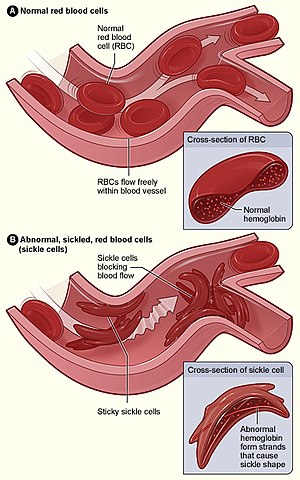Sickle cell anemia
| Sickle-cell disease | |
|---|---|
| Synonyms | sickle cell disorder |
 |
|
| Figure (A) shows normal red blood cells flowing freely through veins. The inset shows a cross section of a normal red blood cell with normal haemoglobin. Figure (B) shows abnormal, sickled red blood cells sticking at the branching point in a vein. The inset image shows a cross-section of a sickle cell with long polymerized sickle haemoglobin(HbS) strands stretching and distorting the cell shape. | |
| Classification and external resources | |
| Specialty | Hematology |
| ICD-10 | D57 |
| ICD-9-CM | 282.6 |
| OMIM | 603903 |
| DiseasesDB | 12069 |
| MedlinePlus | 000527 |
| eMedicine | med/2126 oph/490 ped/2096 emerg/26 emerg/406 |
| MeSH | C15.378.071.141.150.150 |
| GeneReviews | |
| Orphanet | 232 |
Sickle-cell disease (SCD) is a group of blood disorders typically inherited from a person's parents. The most common type is known as sickle-cell anaemia (SCA). It results in an abnormality in the oxygen-carrying protein haemoglobin (hemoglobin S) found in red blood cells. This leads to a rigid, sickle-like shape under certain circumstances. Problems in sickle cell disease typically begin around 5 to 6 months of age. A number of health problems may develop, such as attacks of pain ("sickle-cell crisis"), anemia, swelling in the hands and feet, bacterial infections, and stroke.Long term pain may develop as people get older. The average life expectancy in the developed world is 40 to 60 years.
Sickle-cell disease occurs when a person inherits two abnormal copies of the haemoglobin gene, one from each parent. This gene occurs in chromosome 11. Several subtypes exist, depending on the exact mutation in each haemoglobin gene. An attack can be set off by temperature changes, stress, dehydration, and high altitude. A person with a single abnormal copy does not usually have symptoms and is said to have sickle-cell trait. Such people are also referred to as carriers. Diagnosis is by a blood test and some countries test all babies at birth for the disease. Diagnosis is also possible during pregnancy.
The care of people with sickle-cell disease may include infection prevention with vaccination and antibiotics, high fluid intake, folic acid supplementation, and pain medication. Other measures may include blood transfusion, and the medication hydroxycarbamide (hydroxyurea). A small proportion of people can be cured by a transplant of bone marrow cells.
...
Wikipedia
